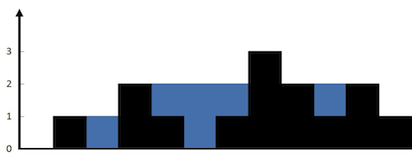Question
Given n non-negative integers representing an elevation map where the width of each bar is 1, compute how much water it can trap after raining.
Example 1:

Input: height = [0,1,0,2,1,0,1,3,2,1,2,1] Output: 6 Explanation: The above elevation map (black section) is represented by array [0,1,0,2,1,0,1,3,2,1,2,1]. In this case, 6 units of rain water (blue section) are being trapped.
Example 2:
Input: height = [4,2,0,3,2,5] Output: 9
Constraints:
n == height.length1 <= n <= 2 * 1040 <= height[i] <= 105
Python Solution
class Solution:
def trap(self, A: List[int]) -> int:
water = 0
left = 0
right = len(A)-1
left_biggest_wall = 0
right_biggest_wall = 0
while left < right:
if A[left] < A[right]:
left_biggest_wall = max(left_biggest_wall,A[left])
if A[left] < left_biggest_wall:
water += left_biggest_wall-A[left]
left +=1
else:
right_biggest_wall = max(right_biggest_wall,A[right])
if A[right] < right_biggest_wall:
water += right_biggest_wall-A[right]
right-=1
return(water)

![[Solved] You are given an integer n and an integer start. Define an array nums where nums[i] = start + 2 * i (0-indexed) and n == nums.length. Return the bitwise XOR of all elements of nums.](https://machinelearningprojects.net/wp-content/uploads/2022/09/Leetcode-solutions-MLP-Feature-Image-1024x536.webp)